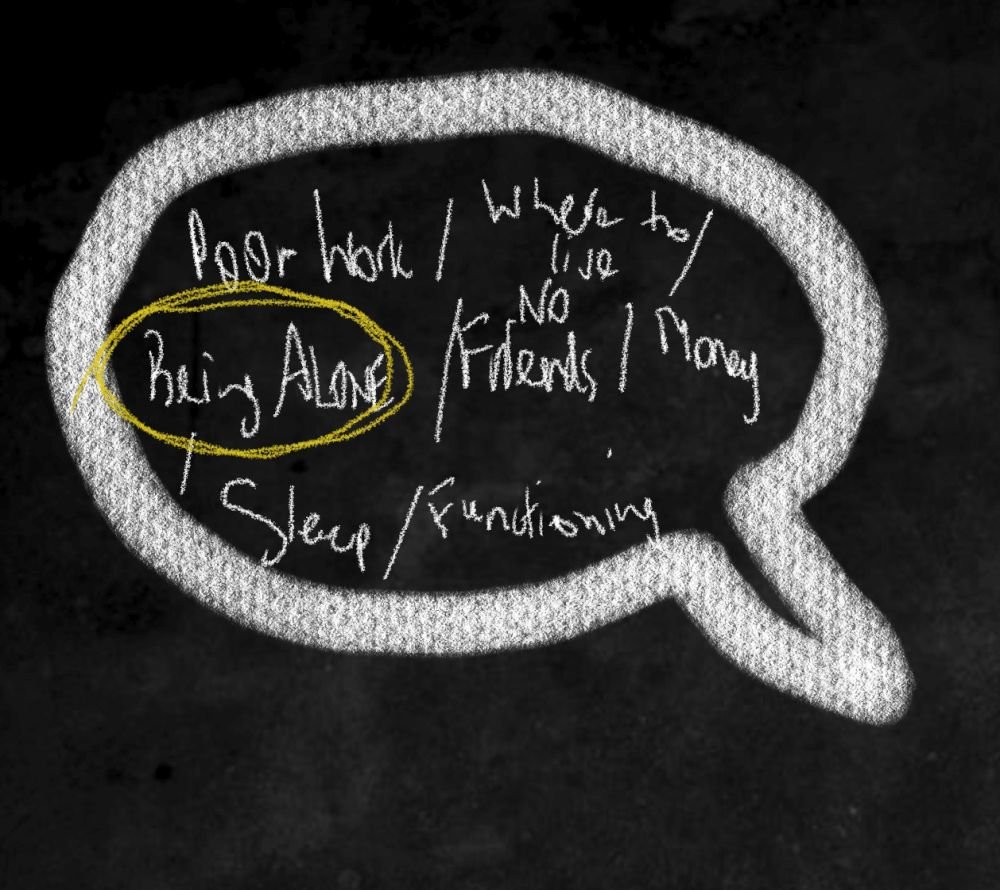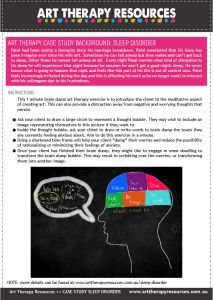THIS POST INCLUDES:
- Art Therapy and Sleep Disorders
- About the Client
- Art Therapy Exercise
- Client Insight and Outcomes
- Disclaimer
- FREE DOWNLOAD Art Therapy Exercise
ART THERAPY AND SLEEP DISORDERS
Many people experience an occasional disruption in their sleep from time to time. In most cases, there is a direct reason for the disrupted sleep such as illness, stress, or situational reasons (jet lag). In most cases, these disruptions are short-term and usually resolve themselves.
However, for some, sleep disturbances are a regular experience and can negatively impact day-to-day functioning. For many people, the first signs of sleep disorders are usually feeling tired at the wrong times. You may be unable to fall asleep at night but feel incredibly tired during the day. You may also find that even if you do sleep at night, you still wake up exhausted.
According, to the American Psychiatric Association, sleep disorders involve problems with the quality, timing, and amount of sleep, which result in daytime distress and impairment in functioning. Sleep disorders often occur along with medical conditions or other mental health conditions, such as depression, anxiety, or cognitive disorders. Sleep difficulties are linked to both physical and emotional problems. Sleep problems can both contribute to or exacerbate mental health conditions and can be a symptom of other mental health conditions.
TYPES OF SLEEP DISORDERS
There are several different types of sleep disorders. The 10 most common sleep disorders are listed below:
- Insomnia – difficult to get to sleep and stay asleep
- Snoring – can be a sign of sleep apnoea or other medical conditions
- Obstructive sleep apnoea – disruption in breathing leading to constant ‘waking’ in sleep
- Sleep hypoventilation – disruption in breathing
- Restless leg syndrome – uncomfortable feeling in legs leading to constantly moving legs
- Bruxism – grinding teeth during sleep
- Narcolepsy – instability between sleep and awake. Experience of cataplexy.
- Sleepwalking and talking
- Nightmares and night terrors
- Rapid eye movement behaviour disorder
SYMPTOMS OF A SLEEP DISORDER
Sleep disruption can have a significant impact on physical, emotional, and psychological wellbeing. Some other common signs of a sleep disorder include:
- You regularly have difficulty falling asleep
- You regularly wake up several times each night
- You often feel sleepy during the day
- You snore, gasp for air or stop breathing for short periods during sleep
- At night you often have tingling in your legs that can be relieved by moving or massaging them
- Your legs often jerk during sleep
- Ongoing fatigue
- Often feel irritable
While these signs may indicate a sleep disorder, a diagnosis requires a medical professional to assess your situation. A sleep study may also help diagnose a sleep disorder.
TREATMENT FOR SLEEP DISORDERS
Treatment methods for sleep disorders can include medical intervention such as medication or sleep aids such as breathing apparatus (CPAP). Treatment can also include personal habits such as:
- Stimulus control therapy
- Sleep restriction
- Sleep hygiene
- Relaxation techniques
- Biofeedback
HOW ART THERAPY CAN HELP WITH SLEEP DISORDERS
Art therapy does not propose to act as a solution for medically related sleep disorders that require medical intervention. However, art therapy can help with sleep disorders that are primarily connected with mental health issues.
Additionally, for those disorders that are primarily medically related, art therapy can still provide the individual with an outlet for psychological distress that is commonly experienced through the process of discovering, diagnosing, and coping with a sleep disorder.
Even if an individual has medical issues that explain their sleep issues, sleep disruption can harm an individual’s ability to emotionally regulate and interact within relationships. Art therapy can help provide a space in which to explore this disruption and how to navigate areas of conflict that arise due to disrupted sleep.
At the most basic level, art therapy can provide a meditative outcome through creating art. This may help people reduce anxiety and stress symptoms so they may sleep better.
Sleep disorders have a significant link to mental health issues such as:
Some of these issues may occur from the disruption to sleep such as depression, anxiety, stress, and substance abuse. Other conditions may foster sleep disturbance issues.
Most psychological approaches to sleep disturbances include changing behaviours around sleep, setting sleep goals, developing awareness of triggers, and learning to develop positive relaxation skills. Art therapy can be used effectively in all of these approaches to help improve sleep.
Art therapy is available to individuals of all ages whereas medical treatments can often be limited by age and other patient demographics. Art therapy is also accessible at any time for the individual where some basic supplies can be accessed.
When and how to use art therapy will depend on the sleep disorder that is presented. Some issues may require the use of relaxation techniques, others may involve the use of more layered exercises that can help the client explore any unconscious fears, anxieties, or stress-related issues.
ABOUT THE CLIENT
- Name: Patel
- Age: 47
CURRENT CLIENT ISSUES:
Patel had been seeing a therapist since his marriage breakdown. Patel mentioned that his sleep has been irregular ever since his wife left. Sometimes he can fall asleep but then wakes and can’t get back to sleep. Other times he cannot fall asleep at all.
Every night Patel worries what kind of disruption to his sleep he will experience that night because he assumes he won’t get a good night’s sleep. He never knows what is going to happen that night and feels like this part of his life is out of control also.
Patel feels increasingly irritated during the day and this is affecting his work as he no longer wants to interact with his colleagues due to his frustrations.
ART THERAPY EXERCISE
This 1 minute brain dump art therapy exercise is to introduce the client to the meditative aspect of creating art. This can also provide a distraction away from negative and worrying thoughts that persist.
INSTRUCTIONS:
- Ask your client to draw a large circle to represent a thought bubble. They may wish to include an image representing themselves in this picture if they want to.
- Inside the thought bubble, ask your client to draw or write words to brain dump the issues they are currently feeling anxious about. Aim to do this exercise in a minute.
- Using a shortened time frame will help your client “dump” their worries and reduce the possibility of rationalising or minimizing their feelings of anxiety.
- Once your client has finished their brain dump, they might like to engage in some doodling to transform the brain dump bubble. This may result in scribbling over the worries, or transforming them into another image.
CLIENT INSIGHT AND OUTCOMES
Patel felt somewhat relieved by dumping his worries into a bubble. He felt he was able to put the worries into a separate space outside of his mind. He started to look at what was worrying him the most and noticed it was being alone.
Patel decided to transform his artwork to include some steps he could take that might alleviate some of his worries. He placed those ideas inside of his mind to suggest those things could occupy his mind better then his worries.
Patel mentioned that creating the artwork gave him a sense of purpose to his thoughts and feelings and was intrigued to use drawing as a tool to process his worrying thoughts in the future.


DISCLAIMER
This case study represents a snapshot of the client’s progress in treatment. The exercise in this article could be used as written or as a guide for new and original tasks developed by the Art Therapist. Responsibility for treatment resides with the individual therapist who understands their clients specific needs. The art therapy exercise should not be viewed as a pre-defined directive on how to treat a client that presents with a specific range of problems.This art therapy exercise will help build a database of knowledge to draw upon when helping your client. Art Therapy is associated with psychotherapy techniques, however each therapist often approaches therapy with their own foundation of psychological interventions, whether it be psychotherapy, CBT, DBT or other methods.
FREE DOWNLOAD: Art Therapy Exercise
Download the FREE Art Therapy Exercise based on the above Case Study. The free download includes instructions for the art therapy exercise, along with an example of the art therapy exercise.

BUILD YOUR ART THERAPY REFERENCE MATERIALS:
Pin this image to your Pinterest board.

SHARE KNOWLEDGE & PASS IT ON:
If you’ve enjoyed this post, please share it on Facebook, Twitter, Pinterest. Thank you!
